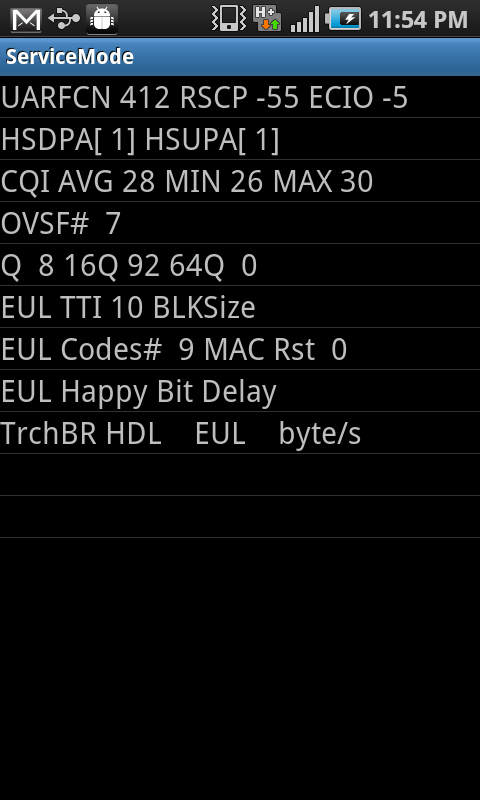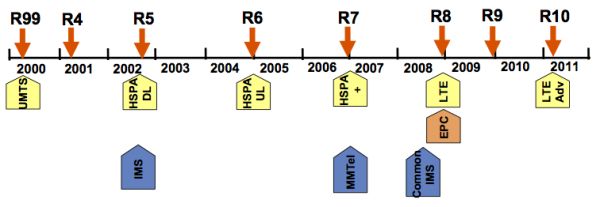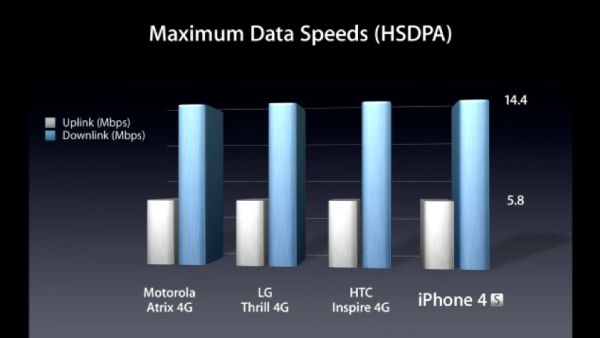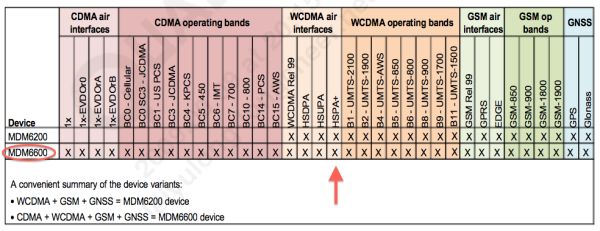The iPhone 4S, HSPA+, and When HSPA+ is Real 4G
by Brian Klug on October 9, 2011 3:30 AM ESTA while after the iPhone 4S announcement, I posted a piece on the iPhone 4S' cellular architecture and talked about the new inclusion of HSPA+ alongside CDMA2000 1x/EVDO and some specifications. Since then, there's been some ongoing confusion about whether the device supports HSPA+, whether it's "4G," and just what all that really means.
It's funny because this issue came up with the HP Veer 4G on AT&T a while back, and with that particular device I did a similar explanatory article in the context of a This Just In post. I wager the somewhat limited cross shopping (and commercial success of the Veer) resulted in many iOS users missing that discussion, and it's cropping up again for the iPhone 4S. The confusion is really twofold. First is a misunderstanding about 3GPP releases and what features are optional or mandatory. Second is a misunderstanding about HSDPA, HSUPA, and modulation coding schemes. Let's break it down.
UMTS standards are defined by an organization known as the 3rd Generation Partnership Project (3GPP), which is a body comprised of partners like telecommunications companies, wireless carriers, and cellular hardware manufacturers. Standards are important, and their formation requires collaboration and discussion. Major revisions are finalized, synchronized, and become "releases." For example the first releases define GSM, release 99 defines UMTS, release 5 defines HSDPA, 6 defines HSUPA, 7 - HSPA+, 8 - LTE, and 10 - LTE Advanced.
This is a huge oversimplification, but you can see how major milestones are bundled up and become releases, and thus when baseband manufacturers like Infineon, Qualcomm, or ST-E release hardware, they're said to be compliant with a given release, and inherit the big features from releases before it.
Where confusion arises is that you don't need to include every feature from some release to say that your hardware is compatible with a given release, and really only features from release 99 are mandatory if you're out to make some UMTS hardware. So when a baseband is "HSPA+" (which really is a colloquial name for the improvements to HSPA made in 3GPP release 7), it doesn't need to include every last feature. Features included in release 7 include things like reduced signaling, faster call setup, continuous packet connectivity, reworked RCC states (idle, DCH, FACH, e.t.c), MIMO, and higher order modulation support. On the downlink, 64QAM or MIMO gets added, and on the uplink, 16QAM gets added.
The confusion in the case of many HSDPA 14.4 (Category 10) devices seems to center on whether it is or isn't HSPA+ if it doesn't include 64QAM support on the downlink (which starts in category 13). This is one of those few times that looking at the Wikipedia table for HSDPA UE categories can be misleading. UE categories with 64QAM are introduced in 3GPP release 7, however it's up to manufacturers to include or not include that feature when actually making hardware. It's interesting to me that all of this misinformation comes up over HSDPA UE category, and somehow HSUPA UE category never gets brought up - I haven't seen anyone claiming that some baseband isn't HSPA+ because it excludes 16QAM on the uplink, yet the overwhelming majority of devices are just using QPSK.
Apple hasn't stated what baseband is in the iPhone 4S (and I guess we won't know absolutely for certain until it gets opened up), but it is almost without doubt MDM6600 just like the Verizon iPhone 4. The specs all line up, and while that part doesn't include 64QAM on the downlink, it does include a number of the other HSPA+ features I've mentioned, and is thus 3GPP Rel.7 and therefore "HSPA+."
Actually using these higher orders of modulation requires favorable radio conditions, of course, and the result is that 64QAM on the downlink or 16QAM on the uplink only gets used in very well tuned systems or cell center. There have been some drive tests done which have shown that 64QAM only really gets used 10% of the time on average. In the iPhone 4S' case here in the USA, it's silly to argue about whether or not the phone can decode 64QAM if AT&T doesn't even use it. A few Samsung devices so far have been based on ST-E's Thor 5730 HSDPA 21.1/Category 14 baseband, and include an engineering menu which shows the percentage of frames encoded using QPSK, 16QAM, or 64QAM.

Note that 64Q is 0. I have run many other tests where 16Q is 100.
I've shown a few other interested people how to see this menu on the Samsung Infuse 4G on AT&T, and thus far none of them has seen any 64QAM frames show up. I've never seen 64QAM pop up either, even with line of sight to the tower in the middle of the night. Those markets include my own in Tucson, AZ, and New York City, which are both AT&T "4G" markets (connoting HSPA+ with improved backhaul) on the coverage viewer. Two data points isn't enough to say conclusively that AT&T isn't using 64QAM, but I haven't seen it yet. You can also see this on video from an Infuse in NYC. Not all AT&T WCDMA "3G" markets are HSPA+, but if you're in a market that AT&T has marked with dark blue (and calls "4G") you can be pretty much assured it's HSPA+.
So the next question is when HSPA+ is and isn't real 4G, and obviously the bar right now is LTE. We've gone over all the real ITU decisions and such in our LTE piece, (whose definition does include DC-HSPA+ and LTE instead of previously just LTE Advanced) but what matters is actual throughput. There's credibility to HSPA+ being comparable to LTE speed as soon as DC-HSPA comes around which aggregates together two 5 MHz WCDMA channels. With all the same features (MIMO, 64QAM, and wider channel bandwidth), DC-HSPA+ gets you approximately to the level of theoretical maximum throughput you can get on LTE. It's easy to see how things are arguably fairly comparable when you consider Verizon uses 10 MHz FDD, and DC-HSPA+ aggregates together two 5 MHz WCDMA channels. Throw in MIMO in addition to just dual-carrier, and maximum theoretical throughput lines up pretty closely as shown in this table by Qualcomm:

That's saying nothing about network latency, however, where LTE will continue to outshine HSPA+. In that case, it does arguably make sense to associate DC-HSPA+ with real LTE and call it real 4G, but until DC-HSPA+ or at least HSPA+ with MIMO it is almost without doubt still 3G. Obviously USA carriers' attempts to pass off HSPA+ 14.4 or even 21.1 as "4G" is immediately laughable marketing, but DC-HSPA+ is arguably real 4G.
Lastly, rumor has it that AT&T and Apple are "working together" to change the 3G status indicator to "4G" for AT&T in the US, a move that would mark the first carrier intrusion into the otherwise completely carrier-untouched iOS. I don't have issue with the status indicators showing H or H+ (for HSPA and HSPA+ when appropriate), but misleading indicators do nobody justice and just serve to reinforce these kinds of misconceptions.













53 Comments
View All Comments
ArunDemeure - Monday, October 10, 2011 - link
I know you talked about Rx Diversity and it's a very good thing you did :) My point was it's easy to underestimate how much of a performance impact it can have - as I said close to 2x in weak signal conditions (which if anything is where it matters most) is fairly realistic.50Mbps out of 73Mbps does seem slightly low but I suspect there's a very good reason for that: MIMO doesn't work as well at low frequencies since the signals can go through walls rather than bounce around. And this might be even more obvious at small distances. Receive diversity keeps working though so two antennas is still very much worth the trouble.
And yes, this means LTE performance at 2.6GHz will be slightly faster than at 700MHz if you can get a very good signal, and that's before you consider 20MHz vs 10MHz deployments. But in reality the signal will fade off so much faster and so much bandwidth will be wasted by people using it indoors with a weak signal that 700MHz will remain the clear leader. Unless you created a much denser network with picocells, and long-term that's the future, but another problem for another day :)
ArunDemeure - Monday, October 10, 2011 - link
Oh and just one more point - the ITU-R did *not* intend to recognise anything as 4G except devices based on standards compliant with IMT-Advanced. The ONLY standards compliant IMT-Advanced that are LTE-Advanced (won't be deployed for at least a few more years) and WiMax2 (aka 802.16m, aka completely dead in the water). The only company which was honest about this was NTT Docomo which called their LTE roadmap '3.9G' until operators pressured the ITU-R to allow practically anything to be called 4G. These branding wars have always been meaningless.Brian Klug - Monday, October 10, 2011 - link
Arun,This is somewhat true, though did you see the revised ITU-R rules? http://www.itu.int/net/pressoffice/press_releases/...
"As the most advanced technologies currently defined for global wireless mobile broadband communications, IMT-Advanced is considered as “4G”, although it is recognized that this term, while undefined, may also be applied to the forerunners of these technologies, LTE and WiMax, and to other evolved 3G technologies providing a substantial level of improvement in performance and capabilities with respect to the initial third generation systems now deployed."
This is what I'm referring to above and in our other LTE piece where we discuss what real 4G is. I'm in total agreement though, the correct way to have solved this is to choose some intermediary number like 3.9G or similar - I couldn't agree more. Obviously they also didn't intend for HSPA+ with none of the additional features (DC/MIMO) to be 4G either.
-Brian
Binkley - Monday, October 10, 2011 - link
This wouldn't be the first intrusion and won't be the last. While Apple has successfully kept crapware off the iPhone, there are a few examples of AT&T's influence on the iPhone, the most vivid the bars/death grip "issue".I worked for 15 years in telecom, specifically handset design and AT&T inherited a poor cell layout plan from Cingular and SBC. As a result, the handset specs mandate a higher than usual power level scheme that wasn't per R99. Carrier specs also typically mandate bar interfaces. On top of that, remember the "more bars in more places" ad campaign? ATT mandated a skewed bar scheme that Apple used until death grip popped up and Apple apparently fell on their sword to correct the "error".
Here's to hoping their will be less intrusion going forward...
cptcolo - Monday, October 10, 2011 - link
R9 = DC-HSPAdeV14nt - Tuesday, October 11, 2011 - link
Apple chose not to call the AT&T version of its phone 4G so as not to bastardize the Verizon version, which clearly cannot be called 4G, at least as subsidized under contract with Verizon.Why would Apple even want their customers to consider that buying an iPhone for an LTE network isn't the brightest idea in the world, and they're actually getting LESS than the folks on AT&T?
They wouldn't. And that's why they didn't. It's exactly the kind of thoughts Apple wants to keep out of people's heads.
If the carriers fight about it, it's a network issue. If Apple brings it up, it's a hardware issue.
Guspaz - Tuesday, October 11, 2011 - link
In my mind, the line between generations should be defined not by technology or specifications, but by what a given standard enables. 3G gave us a huge boost in throughput that enabled a whole slew of rich applications, from Netflix to video calling. So what about 4G?Bumping up the throughput in an incremental fashion, be it from HSPA+ or LTE, that's not enough by itself. It doesn't enable anything we couldn't do before. We might be able to do it a bit better, but there is nothing that was impossible or impractical before that is suddenly possible by having 14.4Mbps HSDPA instead of 7.2Mbps HSDPA.
Latency, on the other hand, does have the potential to be transformative. LTE cuts the latency roughly in half in the real world, or better. We go from 140ms to 70ms, with an effective phone-to-phone latency of let's say 300ms dropping to 150ms.
What does that enable? Tons of stuff. Real-time action gaming, for example. When Carmack was adding multiplayer to the mobile version of Doom, he decided to only support wifi and bluetooth, because the 300ms+ latency he was seeing phone-to-phone over 3G was just not practical for an FPS (even with the best prediction and latency compensation). But drop that down to 150ms and suddenly you're in the realm of playable FPS games. This is true of other types of games too, not just FPS. Some games worked fine with 300ms or higher latency, but some twitch games really needed latency to drop a bunch before they were practical, and now they have.
There are other areas where we'll see big improvements too. VoIP is something that was possible over 3G, despite the latency, but will work a heck of a lot better with LTE's lower latency (and hopefully lower jitter). And I'm sure there are numerous other areas that I haven't even thought of that will see big advancements.
nasula - Monday, December 12, 2011 - link
While you are correct in the basic premise, that delay is important, you assume incorrectly that LTE guarantees lower delays.The delay is mainly due to network architecture and the latest WCDMA architecture is identical to that of LTE (actually even flatter if you take into account the duality of SAE-GW and PDN-GW in LTE).
A modern WCDMA network should offer around 60-100ms RTTs today and those operators that go for the flattened WCDMA architecture,, should be able to offer latencies below 60ms. I've personally seen production equipment in test labs doing sub 30ms.
RoninX - Wednesday, October 12, 2011 - link
Thanks for the article, but I'm a bit more confused now than before (though perhaps less misinformed) .Which phones have DC-HSPA? Does the iPhone 4S have DC-HSPA or does it have HSPA+ 14.4 as implied by the bar chart? Can one expect HSPA+ 21 to be proportionally faster than HSPA+ 14.4? How does HSPA+ 21 compare to LTE?
leexgx - Saturday, October 15, 2011 - link
i have never seen mobile devices used any more then HSDPA 7.2mbs in the uk that is, i have hardly ever seen an phone do more then 2mb in the uk (apart from O2 i can some times nearly max out my HTC desire HSDPA out)as no network is going to upgrade the masks for faster HSDPA, on top of that 500MB to 1GB an month usage is pointless for LTE or HSDPA in Most cases (unless your on giffgaff that is:) )
LTE in the uk would be 4G as it should be able to do speeds higher then 10mb
UMTS and HSDPA is 3g or 3g+/H (some phones show 3g+ for HSDPA)
just wish phone makers would allow HSDPA to be turned off so we can use UMTS only (uses way less power but still very good for Browsing)